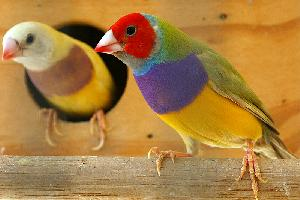
Connu aussi comme
- Pásovník šedý
Description de l'animal
The Australian Zebra Finch, scientifically known as Taeniopygia castanotis, is a captivating small bird that belongs to the Estrildidae family. Native to the vast arid areas of Central Australia, it has adapted remarkably well to its environment, showcasing a variety of interesting physical and behavioral traits that make it a popular subject of study among ornithologists and a favored pet among bird enthusiasts worldwide.Physically, the Australian Zebra Finch is a small bird, measuring about 10 centimeters in length and weighing approximately 12 to 17 grams. It exhibits a striking plumage that is both colorful and patterned, characteristics that have contributed to its common name. The male Zebra Finch, in particular, is known for its vibrant display, featuring a striking combination of black and white stripes on the throat and upper breast, resembling a zebra's patterning, from which it derives its name. The face is adorned with a bright orange cheek patch, while the flanks are dotted with chestnut-colored spots. The body is primarily grey, with a lighter underbelly and a tail that is black with white spots. Females, on the other hand, are more subdued in their coloration, predominantly grey with a less pronounced pattern, lacking the bold face markings and chest spots seen in males.
One of the most fascinating aspects of the Australian Zebra Finch is its social behavior. These birds are highly gregarious, often found in large flocks in the wild, which can sometimes number in the hundreds. They exhibit a strong social structure, engaging in communal activities such as feeding, bathing, and preening. Zebra Finches are monogamous and form strong pair bonds, often remaining with a single partner for life. Their nests are a testament to their intricate social behaviors; constructed with grasses and feathers, these nests are built collaboratively by the mating pairs in bushes or trees, and sometimes even in man-made structures.
Communication among Australian Zebra Finches is another area of interest. They possess a complex vocalization system, with the males being particularly noted for their melodious songs. These songs, which are learned rather than innate, serve multiple purposes, including attracting mates, establishing territory, and reinforcing social bonds within the flock. Interestingly, research has shown that the songs of Zebra Finches can vary significantly from one region to another, indicating a form of regional dialect.
In terms of diet, the Australian Zebra Finch is primarily granivorous, feeding on a variety of grass seeds. However, their diet can also include insects, especially during the breeding season when the demand for protein increases. This adaptability in feeding habits has allowed them to thrive in the harsh conditions of the Australian outback.
The Australian Zebra Finch has also made a significant impact beyond its native habitat. Due to their hardy nature, vibrant appearance, and engaging personalities, they have become one of the most popular avian pets around the globe. Their ease of care and breeding in captivity has led to a wide range of color mutations, further enhancing their appeal to bird enthusiasts.
Despite their popularity in captivity, Australian Zebra Finches continue to face challenges in the wild, including habitat destruction and climate change. However, they are currently not considered to be at risk of extinction, thanks in part to their wide distribution and adaptability. Conservation efforts are ongoing to ensure that these delightful birds can continue to thrive both in their natural habitat and in aviaries around the world.
Animaux similaires
Nouvelles photos d'animaux
Top 10 des animaux
- Dolphin gull (Leucophaeus scoresbii)
- Diana monkey (Cercopithecus diana)
- Moustached guenon (Cercopithecus cephus)
- Galápagos tortoise (Geochelone nigra complex)
- Russian tortoise (Testudo horsfieldii)
- Stone loach (Barbatula barbatula)
- Japanese macaque (Macaca fuscata)
- Common flying dragon (Draco volans)
- Greek tortoise (Testudo graeca)
- Vendace (Coregonus albula)
